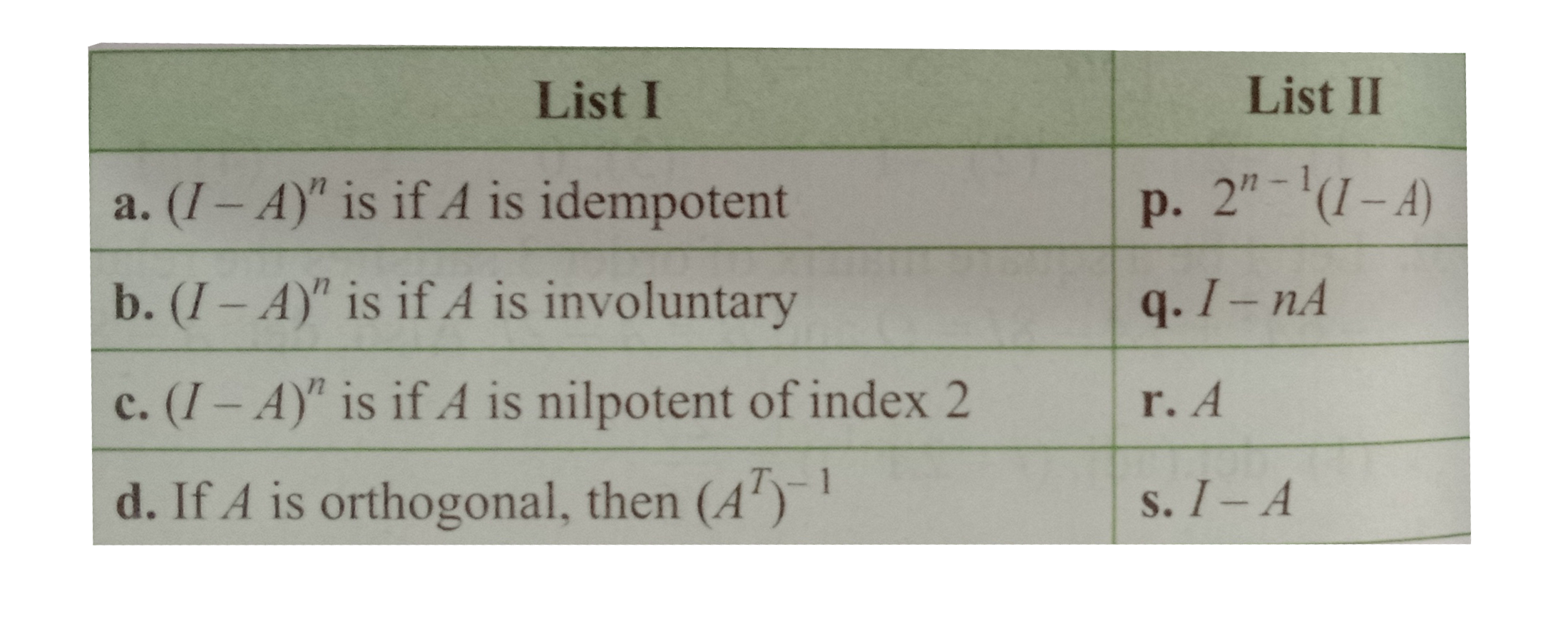A, B and C are three square matrices of order 3 such that A= diag. (x, y, x), det. (B)=4 and det. (C)=2, where x,y,z∈I+. If det. (adj. (adj. (ABC)))=216×38×74, then the number of distinct possible matrices A is ________ .Solution in Tamil
The correct Answer is:9
det. (adj. (adj. (ABC)))=216×38×74
|A|4|B|4|C|4=216×38×74
⇒(xyz)4×28×24=216×38×74
⇒(xyz)4=24×74
⇒xyz=21×71
Number of possible solutions =3C2×.3C2=9
Topper's Solved these Questions
- BOOK - CENGAGECHAPTER - MATRICESEXERCISE - JEE Main Previous Year11videos
MATRICES
- BOOK - CENGAGECHAPTER - MATRICESEXERCISE - JEE Advanced Previous Year26videos
MATRICES
- BOOK - CENGAGECHAPTER - MATRICESEXERCISE - Exercise (Matrix)5videos
MATRICES
- BOOK - CENGAGECHAPTER - MATHMETICAL REASONINGEXERCISE - JEE Previous Year10videos
MATHMETICAL REASONING
- BOOK - CENGAGECHAPTER - METHODS OF DIFFERENTIATIONEXERCISE - Multiple Correct Answer Type7videos
METHODS OF DIFFERENTIATION
Similar Questions
Let A be 2 x 2 matrix.Statement I adj(adjA)=A Statement II |adjA|=A
03:28View SolutionThe number of 3×3 matrices A whose entries are either 0or1 and for which the system A[xyz]=[100] has exactly two distinct solution is a. 0 b. 29−1 c. 168 d. 2
07:20View SolutionMatch the following lists :
 03:52View Solution
03:52View SolutionStatement-1: ~(p↔~q) is equivalent to (p↔q).
Statement-2: ~(p↔~q) is a tautology.02:49View SolutionEvaluate: ∫[√1+x2+x]n√1+x2dx
02:31View SolutionLet matrix A=[[x,y,-z1,2,31,1,2]] where x,y,z varepsilon N. If det.,(adj(adj.A))=2^(8)*(3^(4)) then the number of such matrices A is :
02:42View SolutionIf A and B are square matrices of order 3 such that det.(A)=-2 and det.(B)=1, then det.(A^(-1)adjB^(-1). adj (2A^(-1)) is equal to
03:48View SolutionIf A, B, C are three square matrices of third order such that A=[[x,0,2],[0,y,0],[0,0,z]], det(B)=2^2. 3^2,det(C)=2 where x, y, z in I^+ and det(adj(adj(ABC))) =2^16xx3^8xx7^4 , then find the number of distinct possible matrices A.
06:23View SolutionA and B are square matrices such that det. (A)=1,BBT=I, det (B)>0, and A(adj.A+adj.B)=B.
The value of det (A+B) is02:35View SolutionLet A and B are two square matrices of order 3 such that det. (A)=3 and det. (B)=2, then the value of det. ((adj. (B−1A−1))−1) is equal to _______ .
03:56View SolutionA, B and C are three square matrices of order 3 such that A= diag. (x, y, x), det. (B)=4 and det. (C)=2, where x,y,z∈I+. If det. (adj. (adj. (ABC)))=216×38×74, then the number of distinct possible matrices A is ________ .
05:07View SolutionIf A and B are non-singular matrices of Q. 1 order 3times3 such that A=(adj B) and B=(adj A) then det(A)+det(B) is equal to
04:46View SolutionLet matrix A=⎡⎢⎣xy−z123112⎤⎥⎦ where x,y,z∈N. If det. (adj. (adj. A))=28⋅34 then the number of such matrices A is :
[Note : adj. A denotes adjoint of square matrix A.]03:48View SolutionA and B are square matrices such that det. (A)=1,BBT=I, det (B)>0, and A( adj. A + adj. B)=B.
The value of det (A+B) is10:16View SolutionLet A and B are two square matrices of order 3 such that det. (A)=3 and det. (B)=2, then the value of det. ((adj. (B−1A−1))−1) is equal to _______ .
03:54View SolutionA, B and C are three square matrices of order 3 such that A= diag (x,y,z), det (B)=4 and det (C)=2, where x,y,z∈I+. If det(adj(adj(ABC)))=216×38×74, then the number of distinct possible matrices A is ________ .
04:58View Solution

